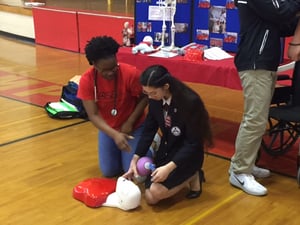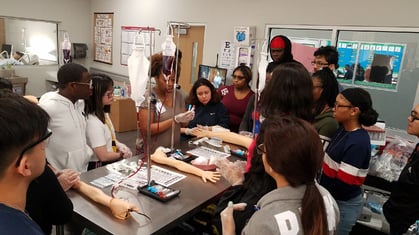With work-based learning becoming more common in CTE programs, teachers and administrators are scrambling for curriculum.
In fact, many educators have asked if AES’s digital curriculum can help with work-based learning.
The short answer is yes!
But you need more than just a one-word answer.
When teachers ask us this question, they really want to know exactly how AES helps teachers and students have success with work-based learning!
On this page, you’ll learn the four ways that AES supports work-based learning programs for CTE teachers, administrators, and students.
First, let’s define what work-based learning is!
What Is Work-Based Learning?

Work-based learning (WBL) is a federally-supported program in CTE that connects students to employers so they can prepare for their careers.
In general, students who are part of a work-based learning program spend time both in the classroom and the workplace.
Depending on the CTE career cluster, WBL opportunities can look very different from one student to the next.
WBL programs typically include:
In addition to these traditional styles of WBL, some CTE programs implement simulated work-based learning or community-based learning for their students.
Simulated work-based learning gives students many of the same experiences as traditional WBL, but without leaving the classroom. This is perfect for schools with limited options to implement traditional opportunities like internships or clinical experience.
Depending on the resources available, teachers can implement simulated WBL with:
- Simulated tools and scenarios: These mimic the look and feel of a day on the job through the use of mannequins, tools, and roleplay situations.
- Simulated workplaces: These make a student feel as if they were truly “on the job” with different settings and tasks.
- School-based enterprises: This model involves students running a business such as a school store or print shop, complete with potential obstacles they may encounter at work.
Community-based learning (sometimes called service learning) combines CTE with community service projects. It connects your classroom to the community in three ways:
- Indirect service projects involve students working behind the scenes of the community by doing projects such as food collections or landscaping.
- Direct service projects put students face to face with the people they are serving and include more interaction with others in the community.
- Advocacy projects are a way for students to identify and eliminate problems in their local community.
You can learn more about the differences of these types of programs by reading this article: Traditional Work-Based Learning vs. Simulated Work-Based Learning vs. Community-Based Learning -- What's the Difference?
Now that you know the different types of WBL, lets talk about how AES helps with these programs!
1. Keeping Students on Task

WBL Program Style: Simulated Tools & Scenarios
CTE programs that incorporate simulated tools and scenarios tend to have one common problem.
They don’t have enough equipment (or bandwidth) for the entire class to partake in hands-on skills practice at the same time.
Many teachers will give students a worksheet to fill out while waiting for their turn to use the tools to practice skills.
But worksheets are often just “busy work” that students don’t find engaging or helpful in reinforcing what they need to learn.
Because of this, teachers have added the AES digital curriculum system as a way to keep students engaged and learning while waiting.
Andy Garret, a health science instructor at Thompson High School in Alabama, has implemented AES to do just that:
“In the setting I work, there is a lot of potential downtime during the times where students are performing hands-on skills practice or testing.
During the time-consuming assessment process that these skills take to proficiently master and complete, it’s important that the remaining students have something productive and student-centered that allows their learning to be consistent.
HealthCenter21 allows me the flexibility to conduct these skills checks while not worrying that other students are not being productive.”
Because students access the digital curriculum individually, all Andy needs to do is tell the students which lessons to complete during the “down time.”
He’s able to keep track of who does the work by simply logging into his instructor dashboard and reviewing student activity.
Andy is just one teacher who embraces the flexibility of the system to make it work for their WBL initiatives.
But keeping your students on task is just the beginning.
What about their long-term information retention?
2. Reinforcing Concepts and Skills with Blended Learning

WBL Program Style: Simulated Workplace
If you have a simulated workplace or lab as part of your CTE program, it’s important to introduce the skills and concepts before jumping right in to the scenarios.
Here at AES, we believe using a blended learning approach is the best way to accomplish this.
Blended learning is an educational strategy that incorporates both digital and traditional teaching methods to improve student learning.
One teacher who fully embraces this teaching style is Sherita Harmon of Alief Center for Advanced Career s.
s.
Part of Sherita’s program involves having students work in what is called their “Clinical Rotation Lab.”
This lab is a type of simulated workplace where students learn and practice hands-on skills as if they were in a real healthcare setting.
So how does AES fit into the picture?
At the start of a new topic, Sherita introduces students to what they will learn, objectives, and the agenda.
Then, she lectures about the topic, during which her students take notes and can ask questions.
After the introductory lecture, students log on to the AES system to complete module lessons, online worksheets, and the other related material while in the classroom.
Once students have gone through all of the lessons in a unit, they complete the unit quizzes to assess their knowledge of what was in the lessons.
Depending on the topic, it can take a few class periods for students to complete all of the lessons and quizzes.
At this point, Sherita takes her students to the clinical skills lab to practice skills related to the AES lessons. The class spends a few days in the lab learning and practicing the hands-on skills.
At the end of her unit, Sherita wraps everything up by having students take the AES module test as a final knowledge check.
Overall, by using this type of blended learning approach, Sherita seamlessly incorporates AES and WBL in her classroom!
You can do the same in your classroom by following her pointers.
But what if your students are in traditional WBL programs like internships, job shadowing, or clinicals?
3. Keeping Students on Track with Your Syllabus

WBL Program Style: Job Shadowing, Internships, Clinicals, & More!
It’s exciting to send your students out of your classroom for job shadowing and internship opportunities.
But how do you teach a class where only some of your students are involved in those external WBL programs?
You need to continue with your classroom lessons and figure out how your WBL students can catch up!
That’s where AES comes in. Our curriculum systems are digital so you and your students can log in anytime, anywhere — as long as you have an Internet-connected device.
For teachers like Nancy Welch, this means students do more than just catch up on textbook readings.
“I use some of the modules to assign students to make up hours for class. It’s not just busy work. I feel that by giving them HealthCenter21 it’s making up for lost time with me in the classroom and they are doing something productive.”
Whether it’s a full unit or a single lesson, you can ensure your students won’t miss a beat when they’re out of the classroom!
So far, we’ve shared three ways that AES can enhance your WBL initiative and make sure your students get the most out of your program.
Digital curriculum also helps with another crucial area of WBL — soft skills.
4. Teaching Soft Skills with Career Readiness Curriculum

WBL Program Style: All of Them!
The purpose of WBL programs is to give your students experience using the skills and knowledge they learn in your classroom.
Even if a student has the hands-on technical skills down, you need to make sure to teach soft skills too!
After all, even your best students can get kicked out of a WBL program (or fired from their future jobs) for acting unprofessionally!
Lori White, a career readiness teacher at Star City High School in Arkansas, has run into this issue plenty of times.
According to her, it’s inspired her to improve her classroom — and her students!
“We’ve heard from businesses that students don’t know how to act in the workplace. They’re lacking the soft skills that are so essential to their success.
We want to make sure we’re sending students that are better prepared for careers.”
This lack of soft skills in young workers is called the “skills gap.” It’s one of the reasons AES creates career readiness content that works for any CTE track or WBL program style.
Is a student interviewing for an internship? They’ll need professionalism and interviewing skills down pat!
Do your students partake in community-based learning? They’ll need excellent communication skills when interacting with others community members!
Does your simulated workplace include scenarios with client interaction? Better hope they have good customer service skills!
Overall, while many teachers may focus on AES learning modules like Phlebotomy or Entrepreneurship, it’s also crucial for students to learn from modules like Customer Service and Professionalism.
When you use AES to teach soft skills up front, you give your students a much better chance of succeeding int heir WBL programs and future careers.
It may seem like common sense, but these days, soft skills are essential to teach in the classroom!
AES & WBL: The Perfect Way to Prepare Your Students for the Future
Whether you’re just starting a WBL program or you’ve got a well-established program, you have a great opportunity to take it to the next level.
But how does AES work with your state’s standards?
You can find out for yourself by checking out our state pages!





 s.
s.

